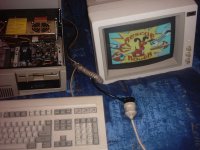Okay I received my latest CGA card, which is a full length one, feature complete with CGA snow \o/
Interesting.
I figured there'd be Taiwanese-made clones that are pretty much a 1:1 copy of the real IBM. But so far the only CGA-compatible chips I've encountered in clone PCs were made by ATi or Paradise.
Screen was rolling+flickering like crazy.
Yes, if you would replace the UM6845 chip with a Motorola 6845, that would fix it

Alternatively, we can release a patch that doesn't use hsych width 0, which avoids this problem on clones.
The Kefrens part does not look correct either (I take it you used a real 8088 CPU at 4.77 MHz?). In fact, it looks similar to what I got on the ATi and Paradise cards. For some reason they don't display any bars at the top part of the screen.
I wonder if this is also the UM6845's doing, or if there's something else that affects that.
The Hitachi-made HD6845 found on some real IBM CGA cards does not have this problem at least.
Those two RCA ports didn't give any picture not even with King's Quest, so I wonder what's up with that.
I wonder why there are two ports in the first place. Perhaps they aren't composite output, but something else?
Looking at the circuitry though, it looks like there should be a composite circuit on there. If you look at the headers in the top-right corner, there should also be a composite signal on those. You could try tapping into that.
On real IBM CGA cards, this is where you can attach a TV modulator. The IBM 5155 uses it to connect the internal monochrome monitor.
The headers on this card look the same, so I suppose they also have a composite signal on there.


